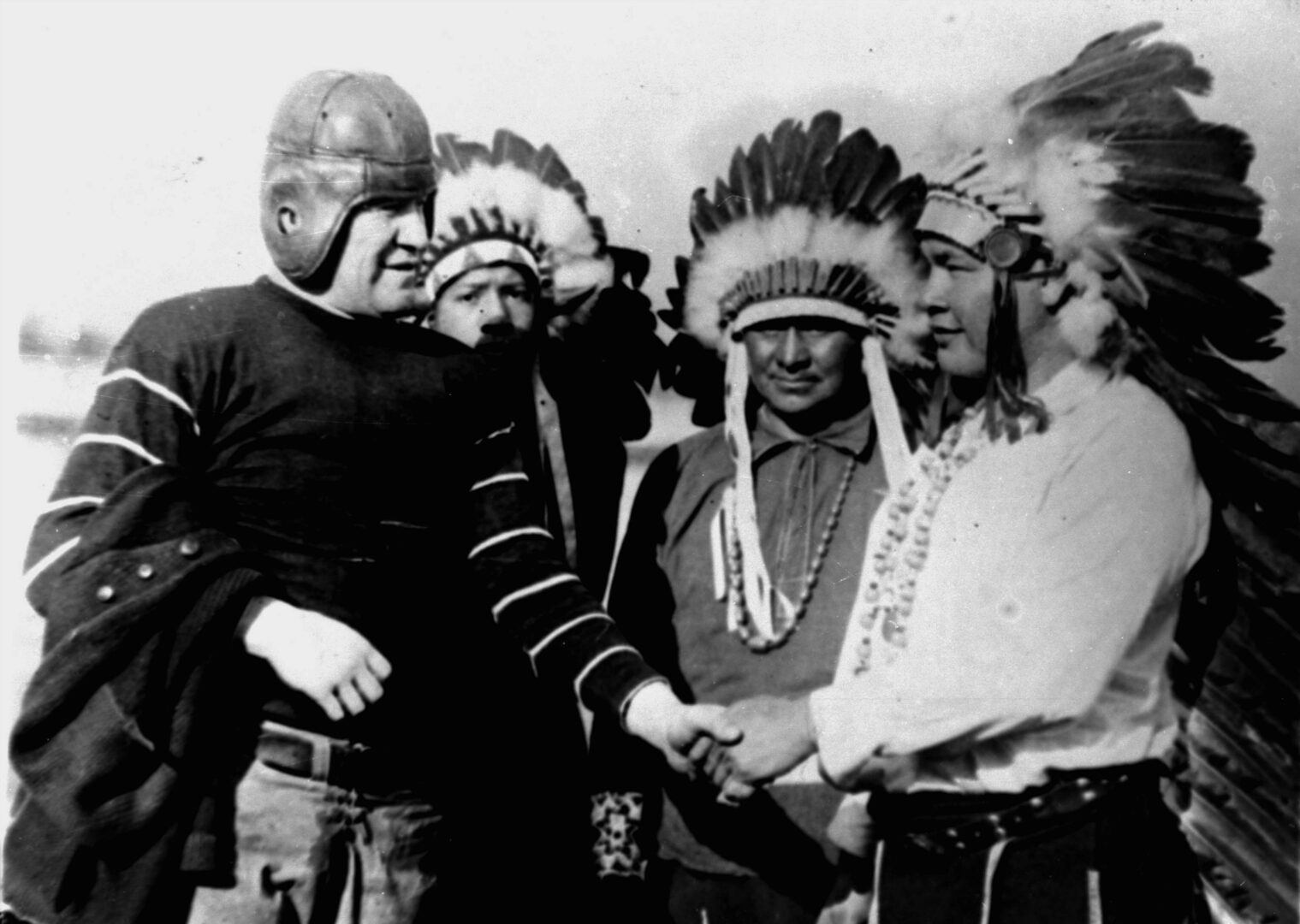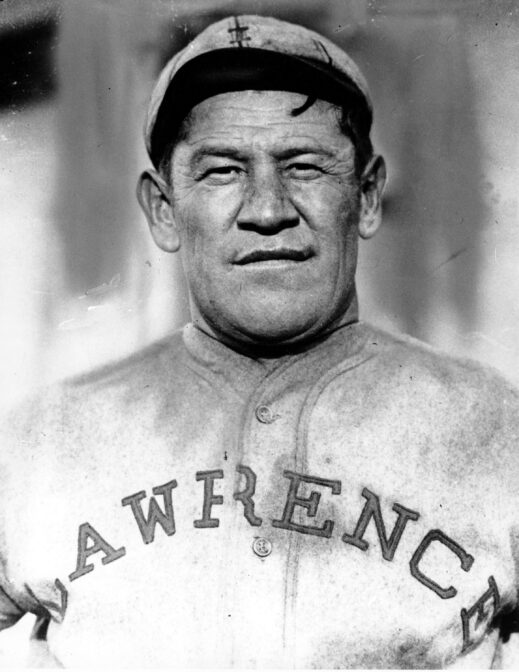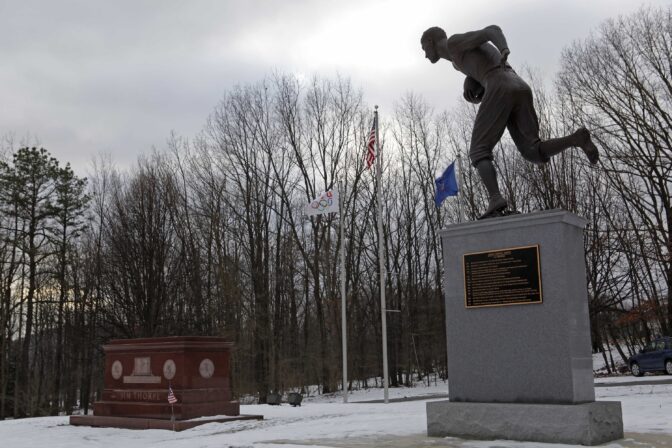
In this undated file photo, Jim Thorpe, left, is greeted by a group of American Indians from a nearby reservation in St. Petersburg, Fla.

In this undated file photo, Jim Thorpe, left, is greeted by a group of American Indians from a nearby reservation in St. Petersburg, Fla.

In this undated file photo, Jim Thorpe, left, is greeted by a group of American Indians from a nearby reservation in St. Petersburg, Fla.
As with many very famous people whose celebrity peaked a century ago, Jim Thorpe is now only faintly recalled by the general public. But a new biography of the world-beating Native American athlete by acclaimed author David Maraniss shows why Thorpe’s story still resonates today.
“Path Lit By Lightning” (Simon & Schuster) chronicles Thorpe from his birth on a Sac and Fox reservation on the Great Plains (located in present-day Oklahoma) to his formative years as a collegiate football star at the notorious Carlisle (Pa.) Indian Industrial School, his stunning victories at the 1912 Olympics, and beyond.
Maraniss delves deeply into the signal controversies of Thorpe’s life, including the stripping of those Olympic medals. But he also illuminates Thorpe’s key role in the formation of the nascent National Football League, and his even lesser-known career later in life as an activist for indigenous rights in Hollywood.
Maraniss is an associate editor at the Washington Post, a two-time Pulitzer Prize winner, and the author of acclaimed biographies of Bill Clinton and Barack Obama. He also has a line in sports: He sees “Path Lit by Lightning” as the third in his trilogy about American sporting icons, including legendary football coach Vince Lombardi (“When Pride Still Mattered”) and Pirates great Roberto Clemente.

This is an undated photo of Jim Thorpe in a baseball uniform. (AP Photo, File)
“Jim Thorpe is both arguably, you know, the greatest athlete America has ever produced, someone who did unparalleled achievements in terms of winning a gold medal in the decathlon, being an all-American football player, the first great player in pro football, and a Major League Baseball player. No one has done that trifecta before or since,” said Maraniss in a phone interview. “But also, it was a chance for me to write about the Native American experience.”
Thorpe was born in 1887 – roughly at the dawn of professional sports, but decades before Native Americans qualified as U.S. citizens. (Indeed, Thorpe was not made a citizen until years after he brought home Olympic gold, in 1912.) The book takes its title from a translation of Thorpe’s prophetic-sounding Indian name.
Like many young Native Americans at the time, he spent much of his youth in boarding schools. At 17, he was shipped to central Pennsylvania and the federally run Carlisle Indian Industrial School. In later years, the school became notorious for the burials of 186 indigenous children who died there and were buried far from their homelands.
“The motto of the founder of the Carlisle School was ‘Kill the Indian, save the man,’” said Marannis. “The idea was take away their religion, their language, their culture, cut their hair, dress them in cavalry uniforms, and make them white, as white as possible. … And the thought was, that’s the only way for Indians to survive in white America.”
It was at Carlisle that Thorpe took up football and track and field. Academically, Carlisle was roughly equivalent to a high school, but students there often remained into their 20s, and its sports teams competed against the athletic powerhouses of the day. In football and track, that meant Ivy League teams like Harvard, Penn and Yale. The speedy and powerful Thorpe—also an expert kicker—became a star in those contests, including a 1912 drubbing of a West Point squad that included future World War II hero and U.S. President Dwight D. Eisenhower.
That contest has been widely mythologized as a peacetime replay of the Army’s slaughter of Native Americans in the century previous. But for Thorpe, bigger moments were yet to come, including the blowout victory in the decathlon at the Stockholm Olympics that made him arguably—before TV, or even radio—the greatest, and most famous, athlete the world had ever seen. (For good measure, he won the pentathlon too.)
The story of Thorpe losing his medals has been told before. Yet Maraniss shows the situation was even more galling than the stripping of his laurels because he’d played two summers of semi-pro baseball. In fact, because Thorpe’s amateur status wasn’t challenged until months after the deadline for doing so, Swedish Olympic officials didn’t want the medals returned. Maraniss reveals that it was Thorpe’s supposed defenders in U.S. amateur athletics—including Pop Warner, the football legend who coached him at Carlisle—who knew Thorpe had been paid to play ball, but sent the medals back to save their own reputations.

Matt Rourke / AP Photo
In this photo taken on Tuesday, Jan. 12, 2010, Jim Thorpe’s tomb, left, and a statue of him, right, are shown in Jim Thorpe, Pa.
In his athletic prime, which lasted another decade or so, Thorpe helped pioneer professional football, starring for the Canton Bulldogs and being named the first president of the fledgling American Professional Football Association, which quickly evolved into the National Football League (in which he also played). In baseball, he was a contemporary of Babe Ruth, but in the majors was mostly a bench player; Maraniss speculates Thorpe was rushed into the league as a turnstile attraction and would have benefited from better instruction and more time in the minors.
Racism shadowed Thorpe’s career. While Black athletes were barred from pro sports for most of the first half of the 20th century, Native Americans could play – but had to suffer endless stereotyping, including sportswriters who couldn’t resist references to wigwams, warpaths, and scalping.
These were also the days when professional athletes were not well paid; most had jobs in the offseason. Thorpe continued playing football and baseball into his 40s, traveling the country for gigs that lasted only months or even weeks. But as his skills deteriorated it was at lower and lower rungs of the game. He lived to age 65, but “[t]he rest of his life was pretty difficult,” said Marannis.
A fascinating corner of Thorpe’s life was his time on the fringes of Hollywood, especially in the 1920s and ’30s. He had bit parts in about 70 movies, including name pictures like “King Kong,” “Meet John Doe” and “White Heat,” and counted Bob Hope among his closest pals.
While Westerns had been a popular genre since the early days of film, Native American characters were almost invariably portrayed stereotypically or as villains, and routinely played by non-Native actors. Thorpe turned activist, lobbying the industry for better parts and more opportunities for Native actors.
Though such battles actually predated Thorpe, his quest for better representation—as well as his embrace of his Native heritage, which only grew stronger as he aged —makes him seem ahead of his time. Still, his success on these issues was limited, at best. Look no further than the 1953 biopic “Jim Thorpe, All-American”: Thorpe was played by Burt Lancaster, and most of the other Native roles went to non-Native actors too.
After his early burst of athletic glory, Thorpe’s story seems largely a sad one: constant financial insecurity, struggles with alcohol, three marriages, and a fragmented relationship with his children. Even his burial place, in the tiny Pennsylvania town posthumously named for him, is the subject of grim controversy. But Marannis said Thorpe’s life wasn’t just one of tragedy. “It’s also a lesson in perseverance. Whatever obstacles society put in his way or of his own doing, he just kept going all the way to the end.”
The days of journalism’s one-way street of simply producing stories for the public have long been over. Now, it’s time to find better ways to interact with you and ensure we meet your high standards of what a credible media organization should be.